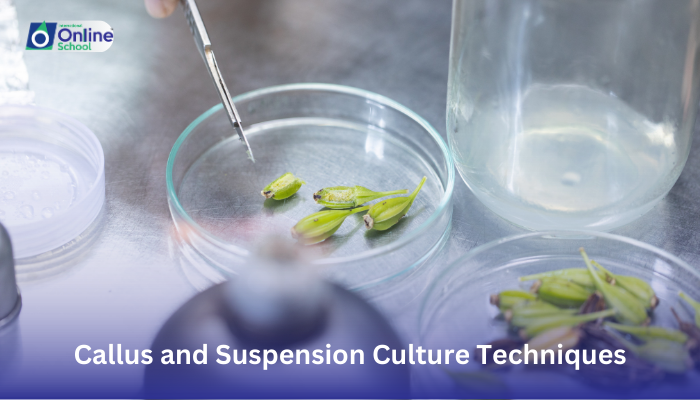
Learning Outcomes:
i. Differentiate between callus culture and suspension culture techniques, highlighting their similarities and differences in methodology and applications.
ii. Explain the concept of in vitro plant cell proliferation and its role in these techniques.
iii. Appreciate the potential of both callus and suspension culture in plant biotechnology and research.
Introduction:
Imagine a land where plant cells dance and multiply, not in soil but in flasks under controlled conditions. This is the fascinating world of in vitro plant cell culture, where scientists unlock the hidden potential of tiny plant pieces to create a multitude of identical offspring. Today, we delve deeper into this green labyrinth, exploring two key techniques that fuel this cellular proliferation: callus culture and suspension culture.
i. The Birth of the Callus: Building the Foundation:
Callus culture is a technique where explants, like tiny bits of leaves, stems, or buds, are placed on nutrient-rich media under controlled conditions of light, temperature, and hormones.
These explants respond by undergoing a process called dedifferentiation, where their cells lose their specialized functions and revert to a primitive state. This mass of undifferentiated cells, called callus, becomes the building block for further growth and manipulation.
Think of the callus as a blank canvas, ready to be painted with the colors of regeneration and development.
ii. The Liquid Waltz: Suspension Culture - A Dance in Mid-air:
Unlike callus culture, suspension culture doesn't rely on solid surfaces. Instead, tiny clumps of callus tissue or even single cells are suspended in liquid nutrient media within flasks, kept in constant motion by shaking or rotating them.
This liquid dance allows for high cell density and rapid proliferation, creating a sea of dividing and differentiating cells. Imagine the suspension culture as a swirling vortex, where cells pirouette and multiply, creating a miniature forest of plantlets within the liquid.
iii. Similarities and Differences: Two Paths to the Same Goal:
While both techniques involve in vitro cell proliferation, they differ in their approaches:
Callus formation: Callus culture prioritizes the formation of a solid callus mass before further differentiation into plantlets. Suspension culture directly induces cell division and differentiation within the liquid medium.
Control and manipulation: Callus culture offers more control over the type of plantlets formed by manipulating the hormone balance in the media. Suspension culture often results in a wider variety of plantlet types due to the dynamic nature of the liquid environment.
Applications: Callus culture is often used for plant regeneration, propagation, and genetic engineering. Suspension culture is ideal for large-scale production of plant cells for research, production of secondary metabolites like medicines and pigments, and studying plant cell metabolism.
iv. The Green Symphony Continues: The Power of In Vitro Cell Culture:
Both callus and suspension culture are valuable tools in plant biotechnology and research:
Rapid propagation: Enabling mass production of disease-free and high-yielding plants for agriculture and horticulture.
Genetic engineering: Introducing desirable genes into plants for improved resistance, nutritional value, or other beneficial traits.
Plant research: Studying plant development, cell differentiation, and metabolic pathways under controlled conditions.
Callus and suspension culture, though seemingly different in their approach, share a common goal - unlocking the hidden potential of plant cells for the benefit of humanity. By understanding their unique characteristics and applications, we gain a deeper appreciation for the intricate dance of life within the plant kingdom and the vast possibilities it holds for a greener and more sustainable future.